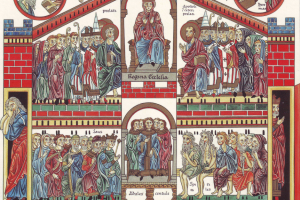Numbers of poor people in the suburbs are growing twice as fast as their city counterparts. But many of these picket-fence poor don’t know where to get help—or can’t bring themselves to ask.
When Ellen got the phone call from Hope House, a long-term homeless shelter in Villa Park, Illinois, confirming an available room, she was overcome with relief. “The tears just flowed,” she says. “Even the woman on the other end was crying.”
It had been a particularly emotional day. Earlier, because she could no longer afford to care for them, she had driven to the DuPage County animal shelter to drop off her beloved cats. “That was probably the most devastating thing I had to do,” she says.
The 62-year-old woman had never expected herself to be homeless. Ellen (who requested her last name not be used) has a stable, full-time job. She had been living in a condo she owned for the last 12 years, but while her adjustable rate mortgage and association fees kept increasing, her income did not, and she couldn’t keep up. She attempted to sell, but in the wake of the housing market crash, the condo’s value had dropped to less than what she still owed on the mortgage. Even a short sale wasn’t possible.
“I fell behind in a lot of my responsibilities,” she concedes. She was able to get her utility bills lowered through a budget plan but couldn’t find assistance with her mortgage payments. The condo went into foreclosure and Ellen, worried she would be physically evicted from her home by the county sheriff, moved into a hotel room paid for by her brother. She spent a few weeks with a friend and several nights sleeping in her car in a grocery store parking lot. She says she wasn’t the only one. The parking lot was scattered with people making their cars home for the night.
“The picture of a homeless person today is nothing compared to what it used to be. They’re not the homeless people sitting on street corners,” Ellen says. “We are normal, healthy, very educated. It’s just that we’ve fallen behind in certain things.”
Recently published data from the Brookings Institute confirms Ellen’s experience. Poverty in 2013 is different from when President Lyndon Johnson declared a “War on Poverty” in his 1964 State of the Union address, when the national poverty rate was about 19 percent and largely concentrated in urban and rural areas. Back then, the suburbs were a symbol of the middle class. A single-family home with a garage and a yard is iconic even today for Americans, and for many it is a sign of success.
But things have changed. Today the national poverty rate is lower—around 16 percent, and 20 percent for children—but the geography is different. According to the Brookings Institute, since 2000 the number of poor people in the suburbs has grown by 64 percent, compared to 29 percent growth in cities. The suburbs are home to 3 million more impoverished residents than big cities and 9.1 million more than rural areas.
Elizabeth Kneebone, a fellow at the Brookings Institute’s Metropolitan Policy Program and coauthor of Confronting Suburban Poverty in America (Brookings Press), says the number of poor in America’s suburbs has been steadily increasing in every decade since the 1980s. The reasons for the shift in location are multiple, she says.
Two economic recessions have certainly contributed, and the foreclosure crisis hit the suburbs the hardest. “Within our 100 largest metro areas, about three quarters of the foreclosures that have occurred since the crash of the housing market happened in suburbs,” Kneebone says. But other trends such as immigration, the relocation of affordable housing, and the replacement of high-paying manufacturing jobs with low-wage retail and service industry jobs are also responsible.
“Put simply, suburban poverty can grow because low-income families are moving into an area or because long-term residents are slipping down the economic ladder. And it’s generally a combination of [those] factors,” Kneebone says.
Isolated incidents
As poverty moves to the suburbs, it presents new challenges for social service agencies trying to meet the growing need, as existing challenges have only been exacerbated in the last decade. According to Brookings, 73 percent of social service agencies in the suburbs are seeing clients who have never needed to seek help before.
One major challenge is a reluctance to ask for help, particularly on the part of people doing so for the first time, says Liz Carter, executive director of the Cincinnati chapter of the St. Vincent de Paul Society, which serves the entire metro area. And agencies can’t help people who don’t ask.
In the wake of the economic collapse, Carter says people who had been living right on the edge, perhaps in low-paying jobs but not quite in poverty, were immediately “right at our door” asking for assistance with a rent payment or a car repair.
With poverty a persistent threat, these people were already familiar with the kind of aid they could receive and where to find it. And when jobs were lost and they had no cushion to fall back on, they were quick to take advantage of those opportunities.
But as time went on, families who previously had 401(k)s and savings accounts started showing up needing much more than a bag of groceries. “They were out of work for so long that they basically drained everything they had. They were in deep holes,” says Carter. “They tend to wait and borrow and get in debt, and they’re behind on their mortgages or rent. So they’re coming to us with big problems, and it just takes more to get them back on their feet.”
She says some people wait so long that when volunteers show up at their homes, they’ll occasionally find that things are grim: families burning pallets in their home for heat, water that has been turned off, cupboards that are bare.
“At the very moment [when] you need all your support around you, so often instead people simply isolate themselves,” Carter says. “They’re very much alone with their problems.”
She says there’s overall a culture of isolation in the suburbs that can breed misconceptions on both sides of the poverty line. People leave their homes through the garage, drive to work, drive home, and go back inside. Opportunities are rare to both share and see struggle. And when talking about “the poor,” stereotypes abound: “They only live downtown, they only look a certain way, and they only have this much education. But it’s just not that way.”
Even St. Vincent de Paul volunteers, already sympathetic to the needs of people in poverty, would sometimes discover through their work that a neighbor was in dire need of assistance. One member told Carter, “Liz, they lived two doors down from me. And I’d get in my car and drive past, and she’d be outside and wave and say hi. You’d never know that behind that door there was this woman and her kids struggling to stay above water.”
Ellen, who’d lost her condo and sought the help of Catholic Charities’ Hope House, says she initially told only one friend what was going on. “The rest of them just knew that I’d moved.”
St. Vincent de Paul in Cincinnati holds as many as 30 to 35 retreats on poverty through its Ozanam Center, ranging in length from a day to a week, in an attempt to combat the misunderstandings that exist. Participants, usually young adults and occasionally parish groups looking to learn more about service to the poor, have the opportunity to hear the personal stories of people struggling. “Instead of ‘here’s your mashed potatoes,’ they get to talk with and learn from people and learn about their lives,” Carter says.
Brian Corbin, executive director for social outreach for Catholic Charities in Youngstown, Ohio, says one reason many of his agency’s clients in the first- and second-ring suburbs don’t ask for help is that they don’t know who could help and what kind of help is available. “They didn’t know how to negotiate any of the social welfare systems,” he says. “They’d never had to.”
That is one reason why faith-based charity and assistance is so important, Carter says. “What they might do is pick up the phone, because there’s a church down the street and maybe there’s someone to talk to.”
Overwhelming demand
But with the increase in need, the St. Vincent de Paul network is having to turn away as many as 25 percent of individuals seeking aid. And they’re not alone. The Brookings Institute reports that many agencies in the suburbs have had to turn away clients, increase waiting lists, and limit client intake hours.
The imbalance between the supply of social welfare services and demand for them is not a problem exclusive to the suburbs. But in an urban core, services are more concentrated and a person may have multiple options of where to go for help. Corbin says that Catholic Charities in Youngstown, which serves six counties, is at capacity, and as new people are experiencing poverty for the first time they may have nowhere else to turn. “In the suburbs, there are fewer social service agencies, because they tend to center in the cities. And so we have to work extra hard trying to build capacity in the suburbs to respond.”
While there are numerous churches with small programs such as food pantries or clothing drives, they’re scattered across a large area, he says. “Churches in the city tend to work a little tighter in a concentrated urban area. In a suburban area, there’s a lot more fragmentation of the social safety net. So trying to create a network mostly from churches trying to meet some of the material needs of people is not as thick of a relationship as there are in the urban centers,” Corbin says. “You have to work much harder at it.”
Tony Stieritz, director of social action for the Archdiocese of Cincinnati, agrees. “As families in poverty begin to live more outside of the immediate urban core, there’s just a lesser density of community services available to them geographically,” he says. “The safety net of social services is much thinner than it is in communities that have traditionally served people in need.”
While government aid through federal, state, and local municipality programs contributes to that safety net, distribution relies on many private and faith-based nonprofits. In the suburbs there are just fewer of those organizations. And funding for those programs, affected by the sequester and Congressional budget cuts, is constantly under threat.
Likewise, most current federal programs that target poverty don’t factor in where the need for those programs is concentrated. While someone experiencing poverty may be eligible for cash-assistance programs, for instance, there is nothing to guarantee that he or she will have access to other social services important for alleviating need.
Youngstown Catholic Charities received a now-dried-up federal stimulus grant to assist with foreclosures, but access to that help depended largely on proximity to one of Catholic Charities’ sites. As Corbin says, “You can only have so many offices.” In the suburbs, money is scarce and so are the avenues for distribution.
Through the U.S. bishops’ Catholic Campaign for Human Development (CCHD), Corbin works with the Alliance for Congregational Transformation Involving Our Neighborhoods (ACTION). This is an interfaith and ecumenical alliance of approximately 15 faith communities that aims to thicken that social network in the Youngstown area by looking at urban/suburban divide issues and working as a faith community around issues such as poverty and economic development, as well as other justice issues.
“We’re using our collective voice to look at social issues. I think that’s something that we have to look at constantly. The church is not just social services or health care. The church is also about convening the community and organizing for justice,” Corbin says.
Funding challenges
With seemingly everyone feeling the financial crunch, funding—a perennial problem for social welfare agencies—has decreased, too. That, coupled with the rapid rise of poverty in the suburbs, has made responding to the need especially difficult. According to the Brookings Institute, 47 percent of suburban nonprofits surveyed in 2009 said they’d lost key revenue sources and anticipated that the worst was yet to come. The result was one in five suburban nonprofits reducing services since the start of the recession and one in seven actively cutting caseloads. Nearly 30 percent were also forced to lay off staff members to cut costs.
Stieritz says that in the Cincinnati archdiocese, collections, including for CCHD, were down for several years. He’s hopeful they’ve started to level off.
For suburban-based organizations, part of the problem is that foundations haven’t been adjusting their funding practices to account for poverty’s relocation. Brookings reports that while foundations may give large amounts of money to nonprofits working to alleviate poverty, it’s not usually to create better infrastructure in the suburbs for meeting need. Funding, despite a shift in poor populations, continues to target the urban core.
One example of this is in metropolitan Atlanta, where the suburban poverty rate is higher than that of other metro areas the Brookings Institute studied. Despite the highest suburban poverty rate, the amount of grant money per person is the lowest.
Additionally, philanthropic support can be harder to come by. Cities like New York, Chicago, and Los Angeles count some of the country’s wealthiest individuals among their residents, meaning nonprofit fund-raisers in urban cores have more access to those assets. Respondents to the Brookings survey said that in suburban communities with increasingly poor populations, fund-raisers aren’t likely to go to church with private philanthropists. There’s less of a chance of their children going to the same schools. The opportunities to have conversations that could turn into financial gifts are limited, if they exist at all.
In Brookings’ Building a Stronger Regional Safety Net: Philanthropy’s Role, one interviewee said about Chicago and its nearby suburbs that philanthropic gifts don’t tend to go to the communities that need it most. “[T]he wealthy communities along the lakeshore identify with Chicago, and that is where the money is going; they don’t identify with the communities to the west. The challenge for fund-raisers, then, is to convince would-be donors to give to an organization in the suburb next door, rather than one in Chicago.”
Long road ahead
The latest job reports seem to signal a turnaround in the economy. According to the U.S. Department of Labor, in 2012, 10.5 percent of families had at least one member who was unemployed, compared to 11.5 percent of families in 2011. But analysts are cautious in their response to the quarterly labor statistics that show an uptick in employment. “There’s been a little job improvement,” Corbin says, “but it really hasn’t trickled down very far.”
And none of those job reports reveal job quality. A job that pays $10 an hour isn’t the same as one that pays a full-time salary and benefits. “People are going back to work, but they’re not going back to where they left,” says Liz Carter of Cincinnati’s St. Vincent De Paul Society. “People who were making $50,000 a year will take a job making $28,000 a year so they at least have something.”
Corbin says food pantries in the Youngstown diocese are reporting an increase in food insecurity. They’re not seeing new people as much as they are seeing an increase in the amount of visits. “It indicates a deeper level of food insecurity than we were aware of just a couple years ago,” he says. “We’re really concerned about that.”
Carter is worried the effects of the current recession will linger for the next 20 to 30 years, as many people depleted their retirement and savings accounts and now have to start over from scratch, often in lower paying jobs. It can be enough to paralyze anyone into fear and inaction, but Carter says it’s important that all Catholics recognize that they have a role to play.
“It doesn’t matter where you are on your journey, there is something that you can do for somebody else,” she says. “And you are not living your faith fully until you take that step.”
This article appeared in the August 2013 issue of U.S. Catholic (Vol. 78, No. 8, pages 16-20).
Image: Photo illustration by Angela Cox; Photo: iStock













Add comment